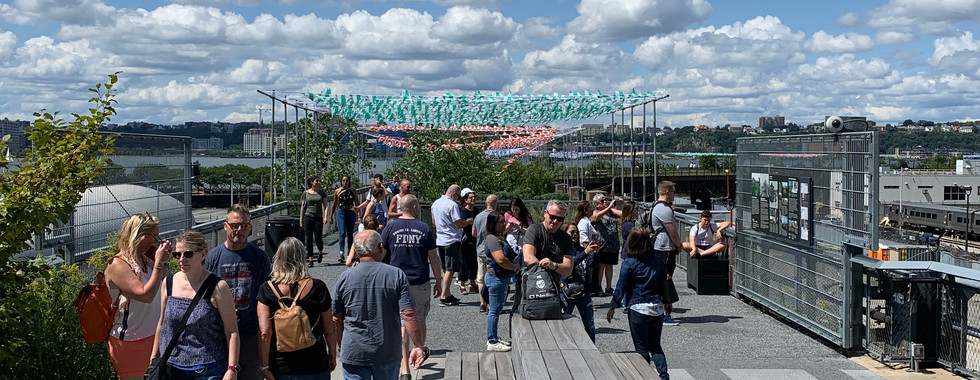Visiting New York's High Line: From Neglected Railway to Lush Urban Retreat
- Mark Vogel

- Nov 20, 2023
- 4 min read
Updated: Sep 19, 2024
New York City ✈

In New York City, I explored The High Line, an elevated linear park, greenway, and rail trail. This unique urban transformation project has become a symbol of innovative city planning. The 1.45-mile-long former freight rail line, elevated above the streets of Manhattan's West Side runs from Gansevoort Street up to 34th Street.
The elevated freight rail line, built in the 1930s, was part of an effort to remove dangerous trains from the city's streets. However, the last train ran in 1980, and the structure was repurposed into a public park in 2009 after being abandoned and overgrown with weeds for decades.
Book a Tour: High Line Guided Walking Tours
“The transformation from an old rail line to a modern urban park is a perfect example of a large city's ability to reimagine and repurpose its spaces, creating something both functional and beautiful.”
Walking the High Line
My journey began at the southernmost access point of The High Line. Ascending the steps, I was immediately greeted by a blend of urban landscape and greenery, setting the tone for this unique experience.
As I walked north towards Hudson Yards, I passed various art installations, which are a key feature of The High Line. These artworks, ranging from sculptures to murals, added a lively cultural dimension to the walk. The elevated views of the city streets below offered a unique perspective, allowing me to appreciate the New York from a peaceful vantage point.
The walkway is interspersed with interesting plants and flowers, showcasing a range of native species. The juxtaposition of natural elements with the cool, unique architecture of the surrounding buildings created a fascinating urban landscape.
Reaching Hudson Yards
Upon reaching Hudson Yards, I observed a stark contrast. This new neighborhood, built atop the former rail yards, features several skyscrapers, including The Edge Observation Deck.
The Edge Observation Deck
The Edge offers panoramic views of the city and is known for its unique design. The observation deck extends away from the building at the top of the skyscraper. Besides the amazing views, you can lie down on a section of the glass floor and admire the tiny people and cars below you. It's a recent addition to the city's skyline and quickly becoming a must-visit spot.
The Shops at Hudson Yards
The area also hosts The Shops at Hudson Yards, a high-end shopping mall with a variety of luxury brands and fine dining options.

The Vessel: A Climbing Sculpture
One of the most striking structures is The Vessel, a climbable sculpture. Unfortunately, as of this moment, it can currently only be viewed from the outside due to safety concerns following several tragic incidents. Its honeycomb-like structure still makes it an intriguing piece of public art.
Final Stretch: Towards the Hudson River
Continuing along the last part of The High Line, I followed the path that winds around Hudson Yards towards Twelfth Avenue and the Hudson River. The fluffy clouds in the clear sky that day added to the beauty of the scene, with spectacular views looking back at The Vessel and the towering skyscrapers.

High Line Fun Facts:
1. Design and Landscape Architecture: The High Line's design is a collaboration between James Corner Field Operations (a landscape architecture firm), Diller Scofidio + Renfro (an architecture firm), and Piet Oudolf (a planting designer). This collaboration resulted in a distinctive blend of industrial architecture and naturalistic planting, which has become a benchmark for landscape architecture worldwide.
2. Art and Cultural Programs: The park is known for its dynamic art program, which includes a range of temporary installations and permanent artworks. These programs often feature works by both established and emerging artists, including sculptures, murals, and performances.
3. Historical Significance: The High Line played a crucial role in the industrial history of Manhattan, particularly in the Meatpacking District. It was part of the West Side Improvement Project, which aimed to improve freight transportation. Understanding this history adds depth to the experience of walking along the park.
4. Ecological Aspects: The plantings along The High Line are inspired by the self-seeded landscape that grew on the disused railway tracks during the years it was left untouched. This approach to planting not only contributes to the park's aesthetics but also supports local biodiversity.

5. Community Impact: The creation of The High Line has had a significant impact on the surrounding neighborhoods. It has been credited with boosting real estate values and spurring development in the Chelsea and Hudson Yards areas. This phenomenon is sometimes referred to as "The High Line effect."
6. Public Programs and Events: The High Line hosts a variety of public events and activities, including guided tours, talks, performances, and family activities. These programs aim to engage the community and enhance the experience of the park.
7. Sustainability and Urban Regeneration: The High Line is often cited as a successful example of urban regeneration and sustainable design. It has inspired similar projects in other cities around the world, demonstrating the potential of repurposing urban infrastructure into green spaces.
8. Accessibility and Inclusivity: Efforts have been made to ensure The High Line is accessible and inclusive. This includes wheelchair-accessible routes, seating areas, and elevator access at certain points.

9. Economic Impact: Beyond its cultural and ecological benefits, The High Line has had a significant economic impact. It has attracted millions of visitors each year, contributing to the local economy through tourism.
10. Global Influence: The High Line's success has inspired similar projects globally, where disused infrastructure is transformed into public spaces. It's become a model for how cities can repurpose industrial areas into vibrant, community-focused environments.
11. Food and Beverage Offerings: Along the park, there are various food vendors and kiosks offering a range of culinary delights. These spots provide a great way to enjoy the views while sampling local and artisanal foods.
The High Line stands as a multifaceted urban park that embodies history, art, ecology, and community engagement, all while serving as a symbol of innovative urban renewal and sustainability. The transformation from an old rail line to a modern urban park is a perfect example of a large city's ability to reimagine and repurpose its spaces, creating something both functional and beautiful.
Book a Tour: High Line Guided Walking Tours














































































Comments